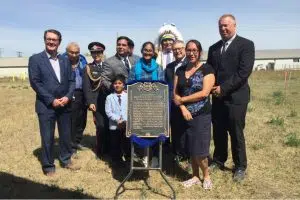A cemetery filled with children under unmarked graves now has a provincial heritage property plaque.
The Regina Indian Industrial School (RIIS) operated in the northwest end of the city from 1891 to 1910. Over those 19 years, many kids never came home.
They often died of tuberculosis, which spread rapidly in the overcrowded school.
The cemetery, located on 701 Pinkie Road, was detected by surveying equipment to hold at least 36 children.
However, there’s likely many more because of the common practice of stacking graves.
The space is now confined by a white fence with flowers and old teddy bears.
The plaque was unveiled Tuesday to remember this dark, but significant part of Regina’s history.

The Regina Indian Industrial School operated from 1891 to 1910 in Regina, Saskatchewan. (City of Regina/Archives)
Past president of the RIIS Commemorative Association, Janine Windolph, began the process of making the site heritage property.
“By making peace with the children and that history, it’s a good healing journey or at least the start to a collective healing journey,” she said.
To her, the plaque represents keeping the children’s graves safe from being torn apart by land development.
“I look at my own kids and think about what it would be like if they weren’t acknowledged,” said Windolph.
She said she continues to contribute to the commemorative association to keep the memories alive of the children who suffered.
“I feel that I don’t have to worry about them being forgotten, that people are responding and listening.”
Vice-chief of the Federation of Sovereign Indigenous Nations, Dutch Lerat, who is also a residential school survivor, made a speech at the event.
“All of our children become part of our families. We’re all interconnected,” he said. “(The plaque) ensures that we as a community and society respect the sacred site as a burial for our children, whose only crime in life was to be born an Indian.”

Mayor Michael Fougere, elder Noel Starblanket and Minister of Parks, Culture and Sport Gene Makowsky were a few of the speakers at the plaque unveiling on August 14, 2018. (Jayda Noyes/980 CJME)
Mayor Michael Fougere said city council unanimously agreed to make the cemetery provincial heritage property in September 2016.
The children who went to the RIIS were from First Nations and Métis communities in Saskatchewan, Manitoba, Alberta and even the United States.
The building was destroyed by a fire in 1948 after serving as the city’s jail and then a home for delinquent boys.











